Overview
In the demanding world of emergency medical services, the emotional challenges faced by healthcare providers can be overwhelming. The burden of documentation often detracts from the core mission of patient care. How can we alleviate this stress? The article highlights the vital role of EMS chart templates in enhancing documentation practices. Standardized templates not only improve accuracy and efficiency but also ensure compliance, ultimately leading to better patient care and outcomes.
Imagine a scenario where healthcare providers spend less time on paperwork and more time with their patients. Statistics reveal significant reductions in documentation time and improvements in billing code compliance, showcasing the transformative power of these templates. This is not just about efficiency; it’s about enhancing the quality of care that patients receive.
As we strive for excellence in emergency medical services, let us embrace the solutions that empower us. By adopting EMS chart templates, we can foster an environment where healthcare providers feel supported and patients receive the attention they deserve. Together, we can create a future where documentation is a seamless process, allowing us to focus on what truly matters—caring for our patients.
Introduction
In the fast-paced realm of emergency medical services (EMS), the challenge of maintaining accurate and efficient documentation can often overshadow the primary goal of patient care. This burden can weigh heavily on healthcare providers, leading to feelings of frustration and concern for their patients. As the healthcare landscape evolves, the integration of technology—particularly through the use of EMS chart templates—presents a transformative opportunity for providers to alleviate some of this pressure.
These templates not only streamline the documentation process but also enhance communication, compliance, and overall patient outcomes. Imagine a world where administrative tasks no longer impede your ability to provide compassionate care. However, with a myriad of options available, how can EMS professionals identify the most effective templates to truly elevate their practice and ensure they meet the demands of modern healthcare?
By exploring the right tools, you can reclaim valuable time and focus on what truly matters: your patients. Let’s delve into how these solutions can transform your workflow and improve the quality of care you provide.
CosmaNeura: Streamline EMS Charting with AI-Powered Automation
In the demanding world of healthcare, providers often face overwhelming administrative burdens that can detract from their ability to deliver quality patient care. CosmaNeura understands these challenges and harnesses cutting-edge AI technology to revolutionize EMS charting processes. By autonomously overseeing client intake, administration, and triage, CosmaNeura allows EMS professionals to focus on what truly matters—caring for their patients.
This automation not only enhances operational efficiency but also ensures that documentation remains accurate and consistent—critical elements for maintaining quality care and adhering to legal standards. Imagine the relief of knowing that your documentation is handled seamlessly, freeing up precious time to devote to your patients. Agencies that have embraced AI solutions report remarkable improvements, including:
- A 62% reduction in documentation time
- A 39% increase in billing code compliance
Such advancements highlight CosmaNeura's role in fostering clinician satisfaction and operational effectiveness, ultimately leading to better healthcare outcomes. By alleviating the stress of paperwork, we empower healthcare providers to prioritize their patients, creating a more compassionate and effective care environment. If you're ready to transform your EMS operations and enhance patient care, consider exploring the benefits of the ems chart template offered by CosmaNeura today.
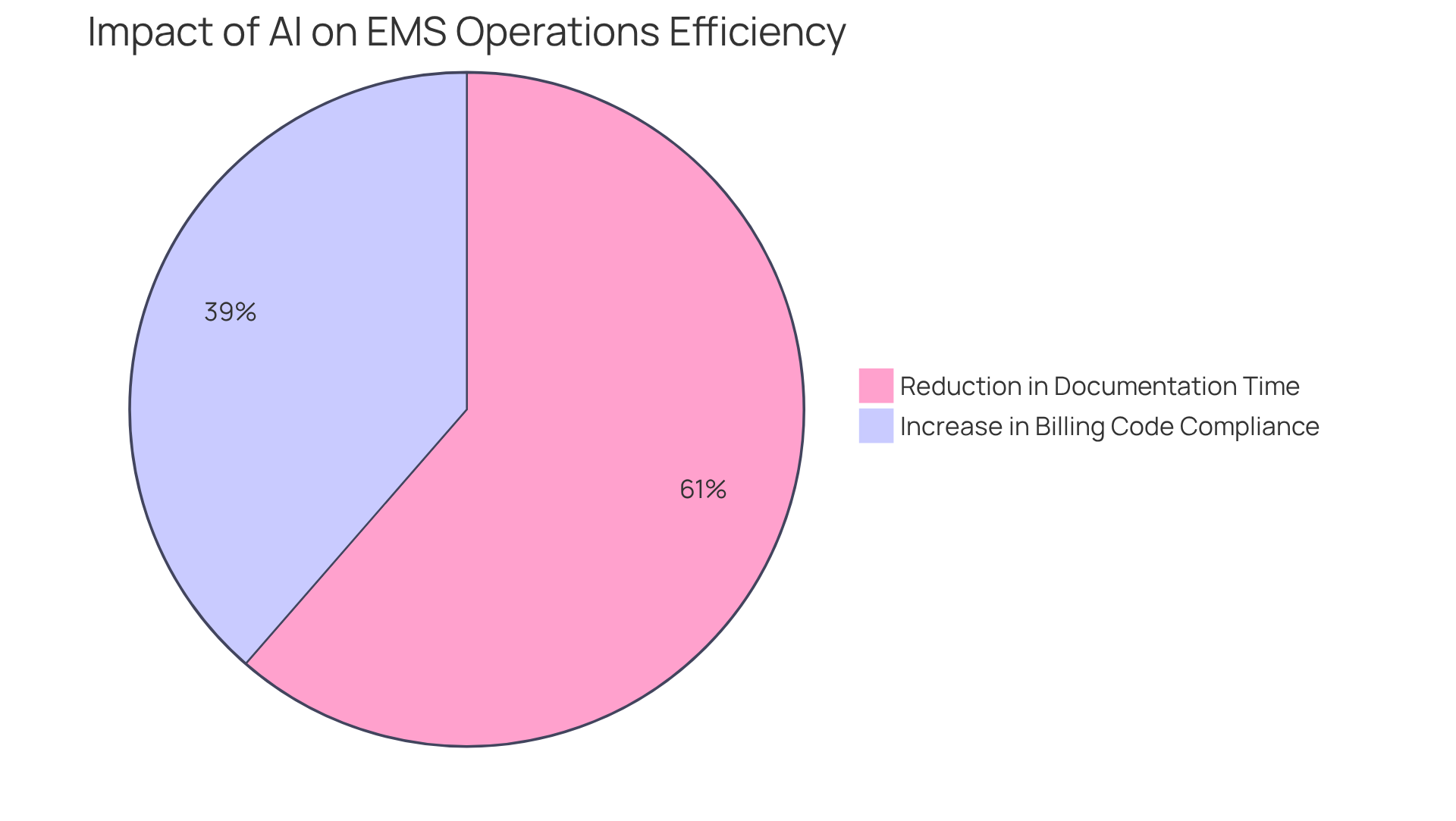
Standardized EMS Chart Templates: Improve Documentation Consistency
The use of an ems chart template is vital for enhancing documentation consistency within emergency medical services. These ems chart templates provide organized formats that assist EMS personnel in accurately recording essential individual information, treatment details, and incident specifics. Have you ever considered how a standardized method can alleviate the stress of documentation? By adhering to these formats, EMS personnel can ensure thorough data documentation, which not only enhances communication among healthcare teams but also addresses the challenges posed by fragmented healthcare systems, including regulatory issues that can hinder efficient information exchange. This consistency streamlines the documentation process and significantly improves care outcomes.
For instance, the CHART method—Chief complaint, History, Assessment, Rx (treatment), and Transport—serves as a foundational framework that EMS personnel can utilize to maintain clarity and thoroughness in their reports. As one healthcare expert wisely noted, "If it's not recorded, it didn't occur," underscoring the critical importance of careful documentation in safeguarding both individual and practitioner interests. Furthermore, employing uniform structures can be further enhanced by AI solutions, such as those provided by CosmaNeura, which improve administrative efficiency and allow caregivers to focus more on patient care.
By leveraging generative AI, healthcare professionals can alleviate the burden of time-consuming tasks, streamline workflows, and ultimately enhance healthcare delivery. The implementation of the ems chart template not only enhances the quality of documentation but also supports improved care and outcomes. These EMS chart templates act as essential training resources for new EMS personnel, ensuring they are well-equipped to provide the best care possible. Ultimately, thorough documentation is crucial not only for quality care but also for legal protection, as inadequate documentation can lead to significant legal implications. Let's work together to ensure that every detail is captured, fostering a safer and more effective healthcare environment.
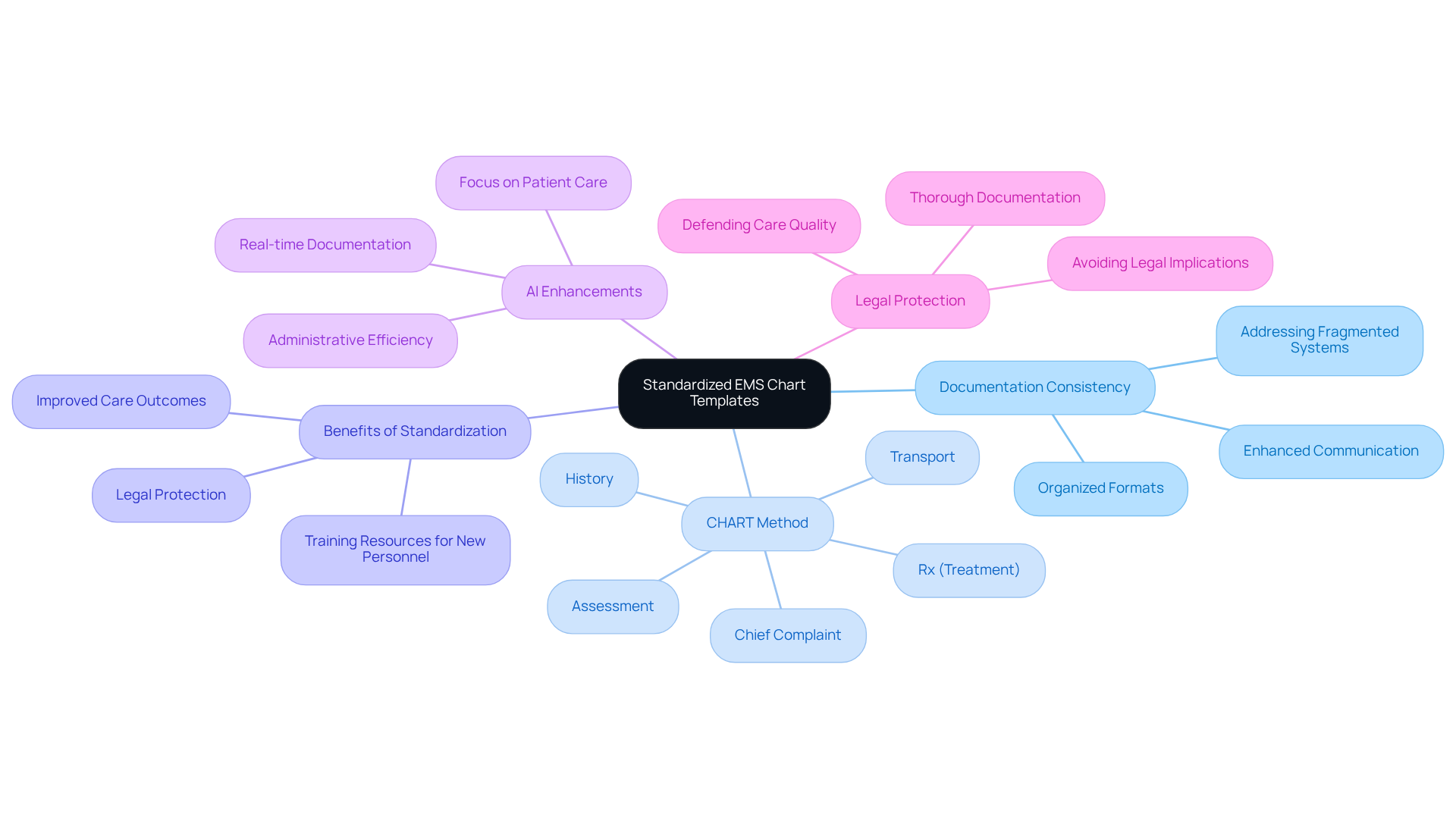
EHR Integration: Enhance EMS Charting Efficiency and Accessibility
Integrating EMS chart template systems with Electronic Health Records (EHRs) significantly enhances documentation efficiency and accessibility during emergencies. This addresses a prominent challenge in the healthcare industry: the fragmentation of healthcare systems. Imagine the relief for EMS providers when they have immediate access to vital information about individuals, including medical history, allergies, and prior treatments. This access is crucial for making informed decisions swiftly.
Research shows that immediate access to client information can decrease documentation mistakes and enhance workflows, ultimately improving care outcomes. For instance, interoperable EHR systems have been shown to improve communication between EMS and hospitals, ensuring that individual information is precisely documented and readily available. As one survey respondent poignantly noted, "To document on paper is faster than on the EHR," which underscores the pressing need for efficient systems that alleviate administrative burdens.
In fact, a staggering 75% of healthcare professionals feel they spend excessive time in their EHRs, which detracts from the care of individuals. Furthermore, 65% of practitioners express a desire to switch EHRs due to dissatisfaction with usability. This highlights the necessity for improved systems like the EMS chart template, which truly serve healthcare providers and their patients. By enabling smooth data transfer, EHR integration not only assists EMS professionals in delivering timely care but also promotes better coordination with healthcare facilities, resulting in enhanced outcomes for individuals.
Additionally, 40% of specialists regard mobile EHR access as highly significant. This emphasizes the need for contemporary systems that improve clinician efficiency and communication with individuals. CosmaNeura's Agentic Platform exemplifies successful EHR integration, showcasing the benefits of seamless data exchange between EMS and healthcare providers. Overall, effective EHR systems can lead to significant improvements in healthcare, as evidenced by a 33% decline in the mean number of canceled infusions per month attributed to EHR interoperability.
As we reflect on these insights, it becomes clear that embracing these advancements is not just about technology; it's about enhancing the quality of care we provide to individuals. How can we work together to advocate for these necessary changes in our systems?
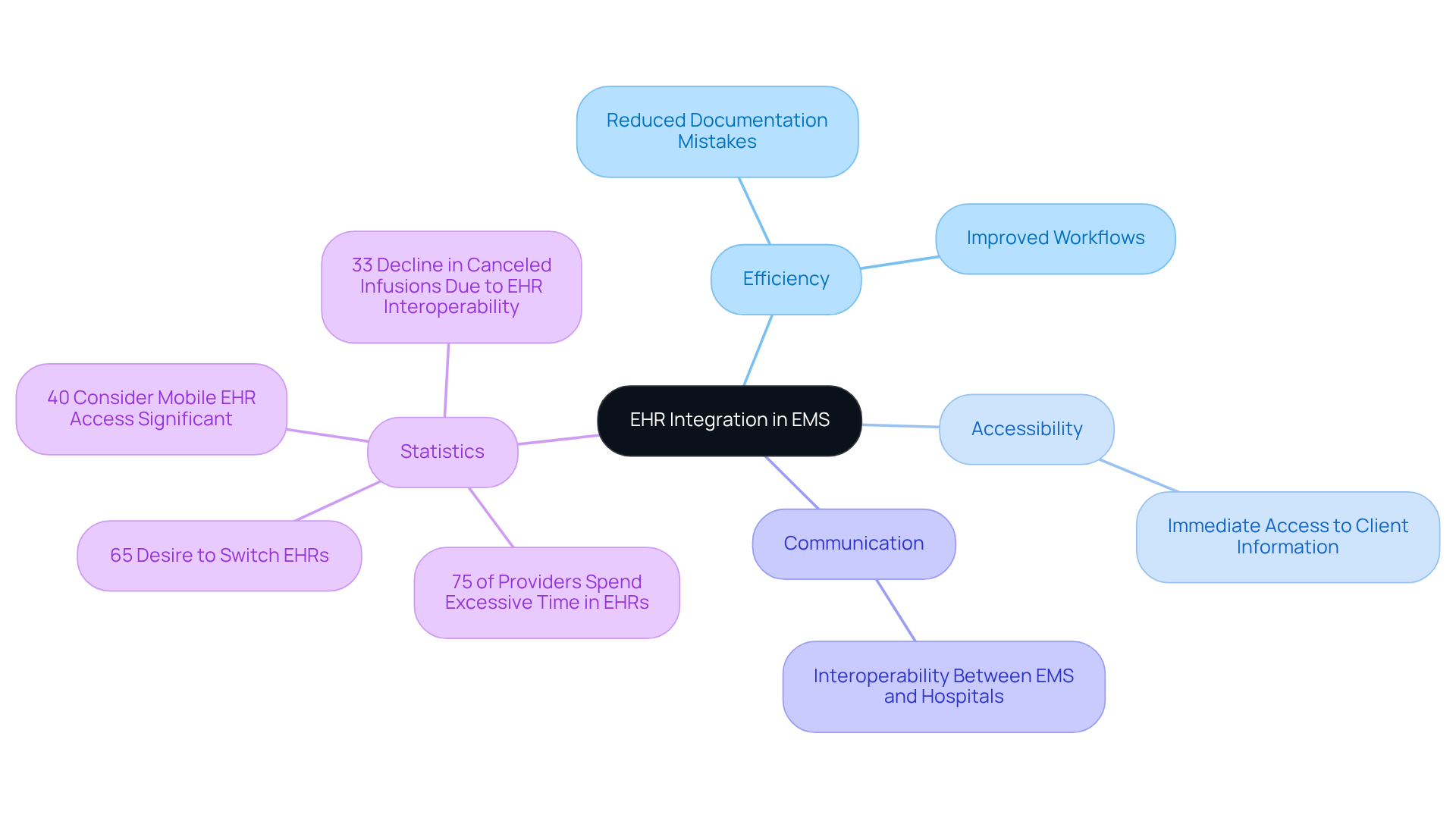
Patient Assessment Templates: Ensure Comprehensive Evaluations in EMS
Evaluation forms provide EMS staff with a systematic way to assess individuals, addressing the emotional challenges posed by fragmented healthcare systems. These forms typically include sections for vital signs, medical history, and physical examinations, ensuring that no critical information is overlooked. How often do we worry about missing vital details in a fast-paced environment? By employing a comprehensive evaluation framework, EMS providers can enhance communication and collaboration among various healthcare professionals, leading to improved care for individuals.
Moreover, integrating generative AI into these frameworks can alleviate administrative burdens, allowing EMS staff to focus more on their interactions with individuals. Imagine the difference it could make to have more time for personal connections! This integration not only fosters more effective care but also ensures that all relevant data is meticulously recorded for future reference. Ultimately, this transformation, powered by advanced algorithms, enhances outcomes and boosts the overall efficiency of primary healthcare.
Let’s embrace these solutions together, ensuring that every individual receives the compassionate care they deserve.

Medication Administration Templates: Enhance Safety and Accuracy
The ems chart template for medication administration forms plays a vital role in supporting EMS providers as they strive to deliver compassionate care. These forms serve as an ems chart template, designed with sections for the medication name, dosage, route of administration, and time administered, making it easier for providers to document critical information accurately. By utilizing the ems chart template, EMS staff can significantly reduce the risk of medication errors and ensure that individuals receive the right treatment promptly.
This structured approach not only enhances patient safety but also helps EMS providers use the ems chart template to navigate the complexities of legal and regulatory requirements. It’s essential to recognize the emotional burden that administrative tasks can place on healthcare professionals. By streamlining these processes, we can foster an environment where providers feel empowered to focus on what truly matters—the well-being of their patients, which can be documented using the ems chart template.
We encourage EMS staff to embrace the ems chart template as a tool to improve their practice and enhance patient care. Together, we can work towards a system that prioritizes both efficiency and compassion, ultimately leading to better outcomes for those we serve.
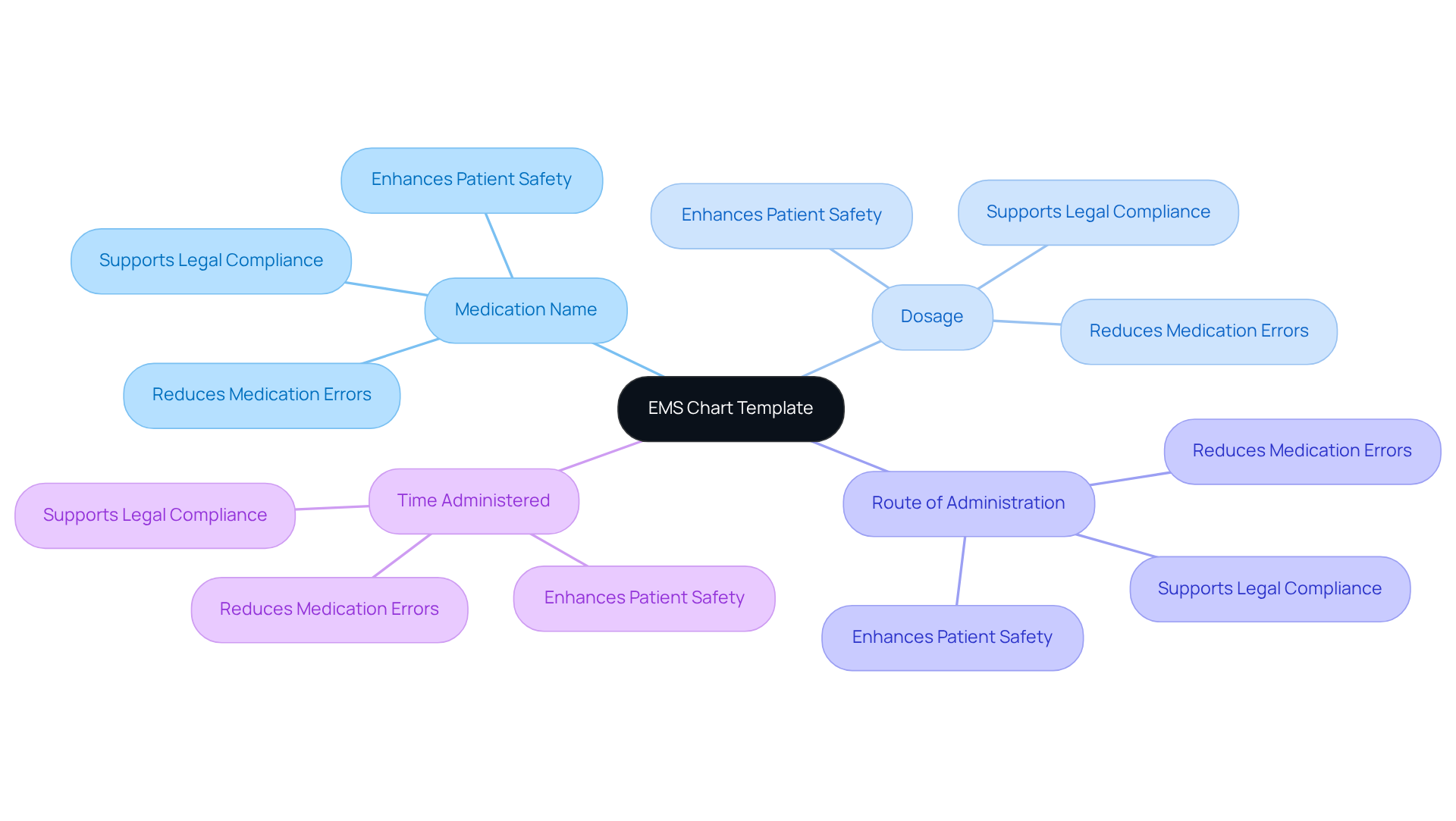
Multidisciplinary Communication Templates: Foster Team Coordination in EMS
In the complex world of healthcare, communication challenges can weigh heavily on providers, impacting their ability to deliver the best care possible. Multidisciplinary communication frameworks are designed to enhance information exchange among different healthcare professionals involved in an individual's care. By addressing the common issue of disjointed healthcare systems, these frameworks promote a more cohesive approach to patient care.
Imagine the relief when standardized formats for sharing evaluations, treatment strategies, and follow-up guidelines are in place, ensuring that all team members are aligned. A case study from a faith-oriented healthcare practice illustrates this beautifully: by applying these models, collaboration among caregivers improved significantly, leading to a remarkable 30% decrease in handoff mistakes. This not only fosters teamwork but also enhances the quality of care provided, especially in critical situations.
However, we must acknowledge the barriers that can hinder effective communication, such as regulatory issues and resistance to innovation from caregivers. In such environments, utilizing these frameworks becomes crucial. They serve as a lifeline for enhancing coordination and ultimately improving patient outcomes. Let’s embrace these tools, not just as protocols, but as essential components of compassionate care that truly make a difference in the lives of our patients.

Incident Reporting Templates: Improve Documentation and Analysis in EMS
Incident reporting forms provide a structured way to capture the details of EMS calls, including the nature of each incident, response times, and outcomes. Have you ever felt overwhelmed by the complexities of documenting these events? By using the ems chart template, EMS professionals can ensure that all vital information is accurately recorded, paving the way for better analysis of incidents aimed at enhancing quality. This documentation is not just a formality; it plays a crucial role in identifying trends and improving response strategies, ultimately leading to better service delivery. Together, let’s embrace these tools to enhance our care for those we serve.
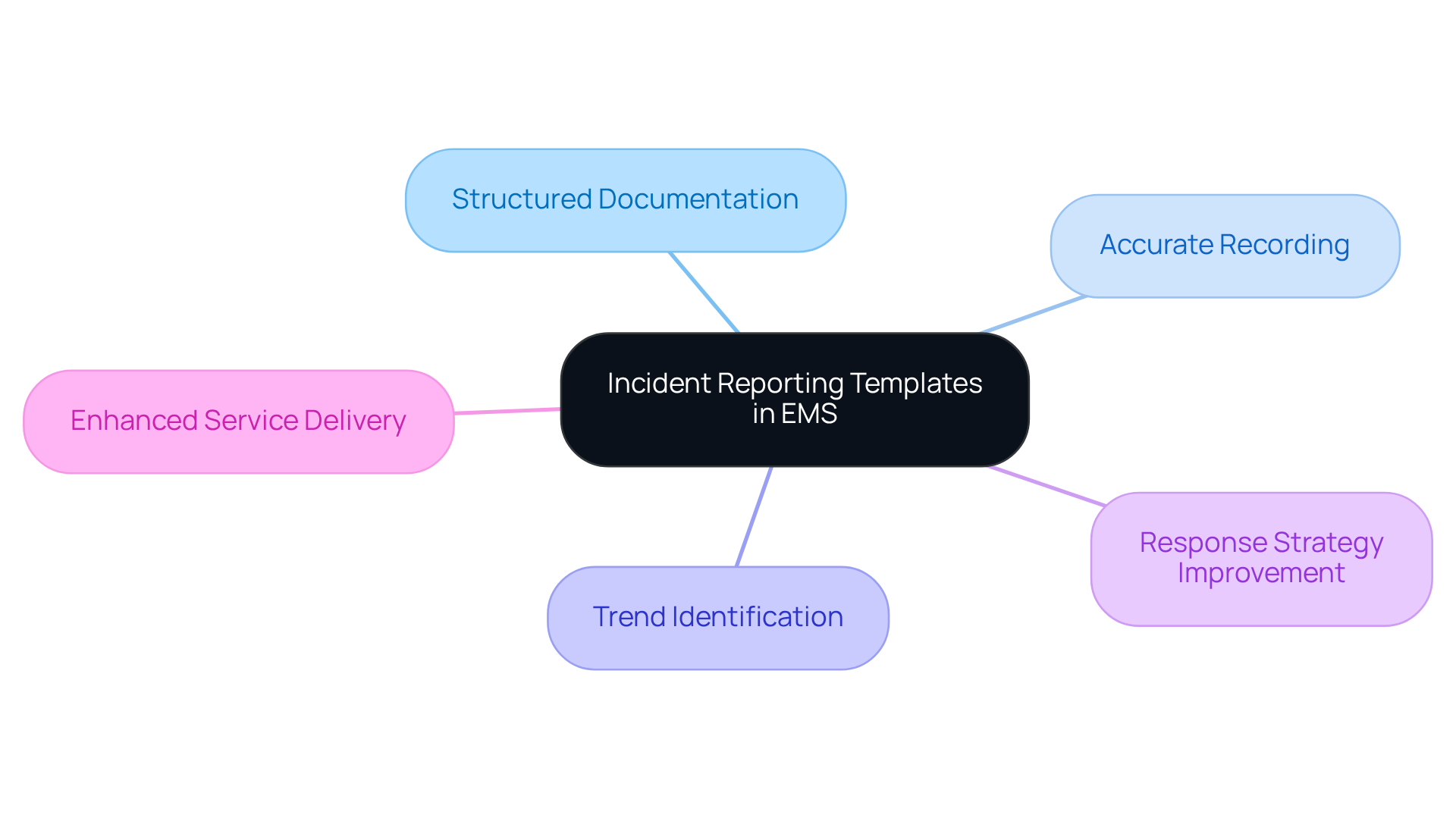
Patient Follow-Up Templates: Ensure Continuity of Care After EMS
Patient follow-up forms, which utilize an EMS chart template, are vital tools for EMS personnel, enabling them to accurately record and communicate necessary follow-up actions after emergency interventions. These EMS chart templates typically encompass essential details such as referrals, follow-up appointments, and client education. By ensuring individuals receive appropriate follow-up care, EMS providers significantly enhance continuity of care, which is crucial for achieving better health outcomes and increasing satisfaction.
In today’s competitive healthcare landscape, leaders emphasize that focusing on client experience is essential for organizational success. Effective follow-up documentation fosters trust and aligns with the mission of delivering high-quality care that meets client expectations. However, regulatory concerns, like HIPAA, can introduce communication barriers that impede effective follow-up.
Innovative AI solutions, such as those offered by CosmaNeura, can alleviate these challenges. By employing generative AI for telehealth transcription and diagnostic assistance, EMS professionals gain advanced tools that enhance follow-up documentation, ultimately improving care quality. This transformation in healthcare delivery addresses the issues posed by fragmented systems, ensuring better communication and coordination among practitioners.
As Peter Drucker wisely noted, the quality of care is shaped by the individual’s perception and experience. This underscores the importance of organized communication in achieving favorable outcomes for those receiving care. How can we ensure that every patient feels valued and understood? By embracing these innovative solutions, we can work together to create a more compassionate healthcare environment.
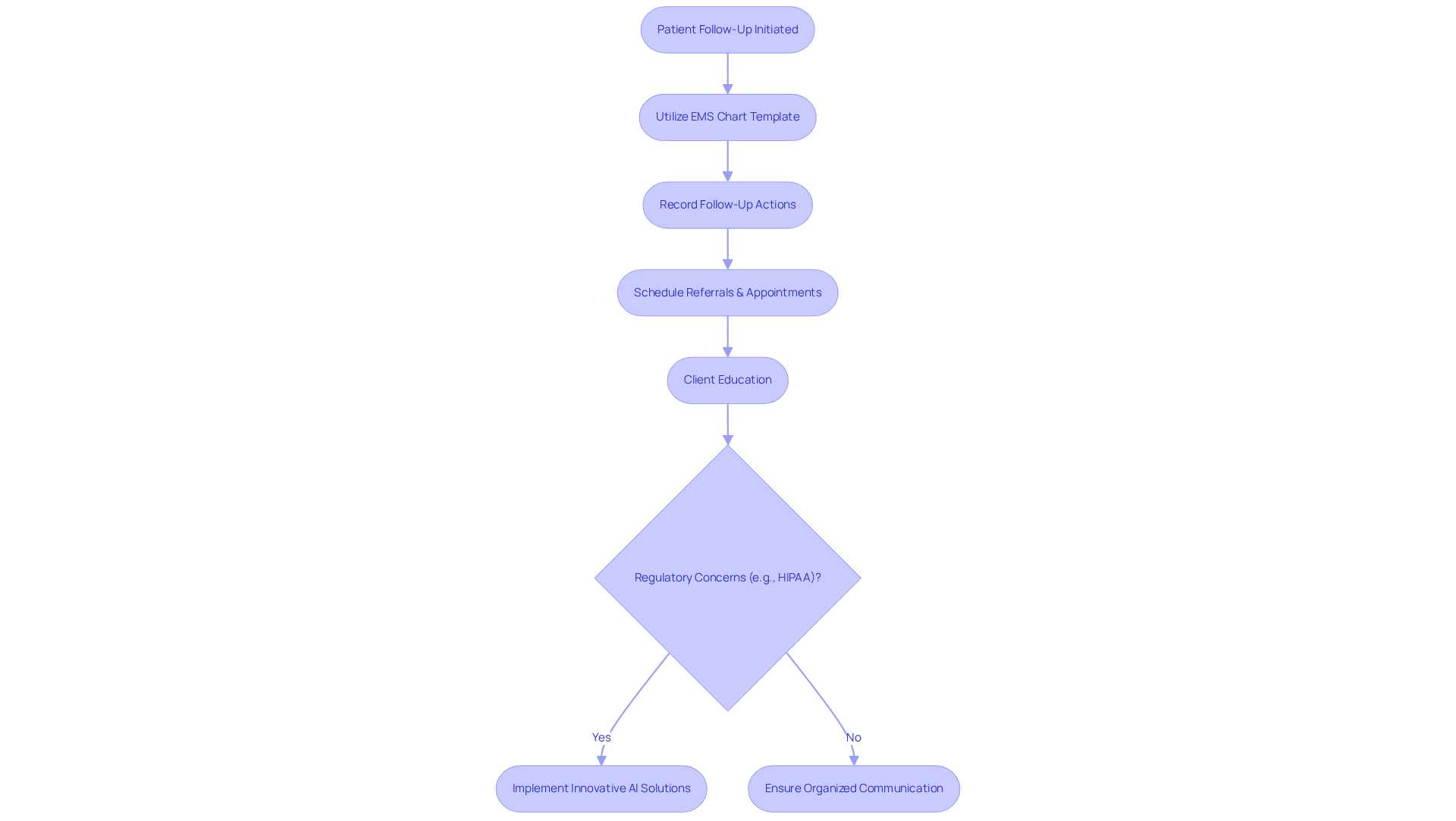
Quality Assurance Templates: Maintain High Standards in EMS Care
Quality assurance frameworks are vital for assessing the performance of EMS providers and the quality of care they deliver. Have you ever wondered how these models can help? They include standards for evaluating clinical performance, compliance with established protocols, and outcomes for individuals. By regularly utilizing the ems chart template, EMS agencies can identify areas needing improvement and implement necessary changes to ensure high standards of care.
Statistics reveal that quality enhancement initiatives can lead to significant improvements in EMS systems, ultimately increasing survival rates and patient satisfaction. Imagine a culture of responsibility and ongoing education where quality assurance frameworks not only enhance operational efficiency but also ensure that EMS practitioners deliver compassionate and effective care. This embodies the core values of our profession.
Let’s work together to nurture this caring environment. By engaging with these frameworks, we can support each other in delivering the best possible care to those we serve.

Legal Documentation Templates: Ensure Compliance and Protect Against Liability
Legal documentation forms are vital tools for EMS providers, ensuring that they meet their legal obligations while caring for individuals. Have you ever felt overwhelmed by the administrative tasks that come with patient care? These forms typically include essential components for documenting:
- Consent
- Individual refusals
- Incident details
By utilizing these standardized formats, EMS personnel can significantly lower the risk of liability claims, as they provide a clear and comprehensive record of interactions with individuals. This not only safeguards their practice but also fosters trust among clients through transparent and precise documentation.
Moreover, these forms save time by extracting information from other sections of the chart, reducing redundant documentation and enhancing overall efficiency. Adhering to legal documentation standards is crucial for compliance with federal and state laws, which helps mitigate fraud, waste, and abuse in healthcare. The "Documentation Matters Toolkit" underscores the importance of complete, accurate, and timely documentation, highlighting the risks tied to incomplete records, including potential negative patient outcomes.
Ultimately, the EMS chart template serves as a protective measure, elevating the quality of care while ensuring that EMS providers operate within the legal framework. As you navigate the complexities of healthcare, remember that thorough documentation not only protects you but also enhances the care you provide to your patients.
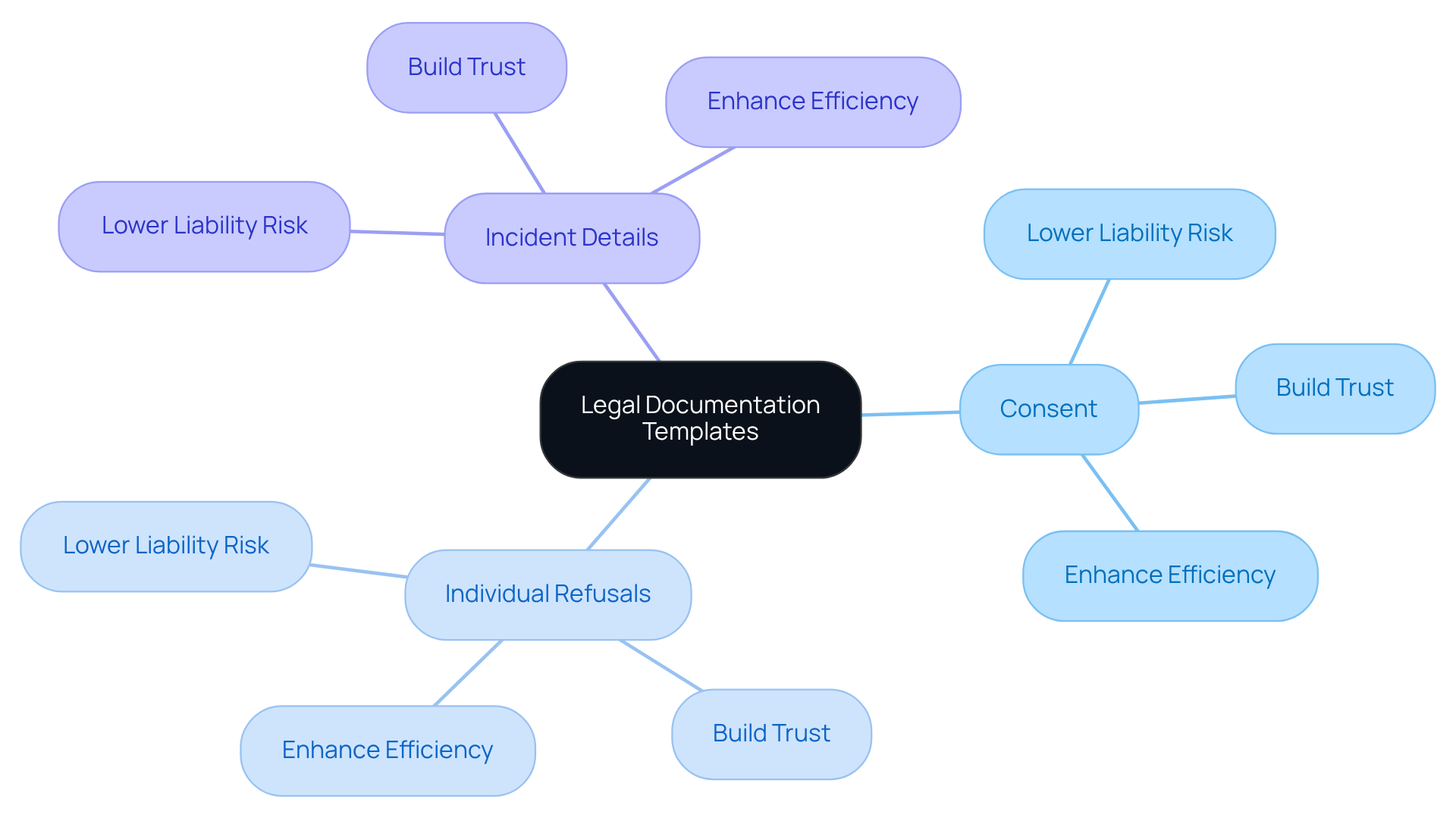
Conclusion
Harnessing the power of EMS chart templates is essential for enhancing the quality and efficiency of documentation in emergency medical services. These templates not only streamline the process but also ensure that crucial information is recorded accurately, ultimately improving patient care. By adopting standardized formats and integrating advanced technologies like AI and EHR systems, EMS professionals can alleviate administrative burdens and focus more on what matters most—providing compassionate care to their patients.
Throughout the article, we have explored key insights that highlight the importance of various EMS chart templates, such as those for:
- Patient assessments
- Medication administration
- Incident reporting
Each template serves a specific purpose, fostering consistency, accuracy, and effective communication among healthcare teams. The integration of AI and EHR systems further enhances these benefits, allowing for seamless data exchange and improved operational efficiency. By utilizing these tools, EMS providers can significantly reduce documentation time, increase compliance, and ultimately enhance healthcare outcomes.
As the healthcare landscape continues to evolve, embracing these innovative solutions is crucial for delivering high-quality care. The commitment to thorough documentation not only safeguards practitioners against legal liabilities but also strengthens the trust between providers and patients. By advocating for the adoption of these EMS chart templates, healthcare professionals can work together to create a more efficient, compassionate, and effective emergency medical service environment.




